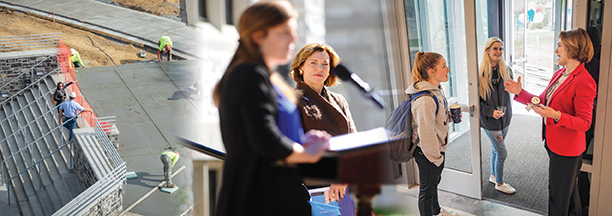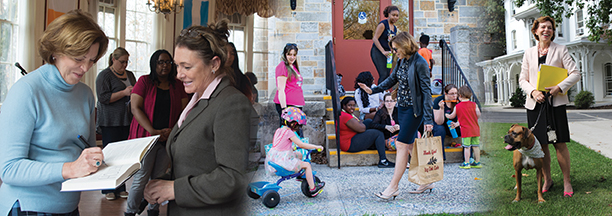President Barbara K. Mistick is stepping down after eight years at the helm at Wilson to become president of the National Association of Independent Colleges and Universities. She sat down with magazine editor Darrach Dolan to discuss her time at Wilson and what she believes her legacy and lasting impact will be on the College.
Q. Prior to coming here, you were president of the Carnegie Library of Pittsburgh, the city’s public library system, and you are credited with saving it. How and why did you become president of Wilson College?
A. I’m not sure I saved the Pittsburgh library system. I think large systems like that are going to survive anyway. The challenge is to make them relevant. What I did was find an alternative funding source that made all the difference.
As for coming to Wilson, I was playing golf with Robin Bernstein, who was on the Board of Trustees, and about midway through the game she told me Wilson was searching for a new president. I had just decided not to renew my contract with the library and was looking for a new challenge. I said I might very well be interested. Next thing I knew I was at Wilson being interviewed.
The board made it very clear they felt their current model wasn’t sustainable and were looking for someone who would act as a change agent. Throughout my career, I’ve been inspired by such challenges.
Q. Ironically, the first challenge you faced at Wilson was the repair and restoration of the library. How did that set the tone for your presidency?
A. When I was interviewing, the library director, Kathleen Murphy, asked me to come over and she showed me all the things that needed work. I’d overseen the renovation of 10 libraries and honestly I’d seen some in worse shape than Wilson’s. But I didn’t expect the whole heating system would fail between my interview and starting here.
It might have intimidated a lot of people to find the library, the heart of the campus, out of action. But I had a sense of what it could become and I knew it needed more than just a Band- Aid or the heating-system fixed—it needed a complete redesign to make it student centric, contemporary and responsive to student needs. My very first decision here was to close the library and move it to a temporary location until we could do that.
You want to enhance the system you’re in. You want to leave it in a better place than when you got there and in a financially sustainable place. If there’s been a common thread in the things I’ve set out to do here, it’s that they are fiscally sustainable, will serve the institution long-term and will serve the greatest number of constituents.
Q. Setting the library restoration aside, what were your original goals, did you achieve them and what challenges did you face along the way?
A. You never achieve everything. It’s all on a continuum. This institution is 150 years old and the things I was able to achieve were because of the leadership before me going back all those years.
My initial goal was to create a more vibrant community and the only way to have a more vibrant community was to have more students. I’d tell everyone that we could be small, but we couldn’t be tiny, and we had gotten tiny and tiny isn’t sustainable.
The move to add health sciences was a very logical move for us. I think some people were worried about our commitment to the liberal arts because nursing is a professional-track program. But Wilson made a commitment long ago to active learning that includes professional tracks, so we should think of Wilson as a liberal arts college with professional development elements. The College has responded to workforce needs in the community throughout its history—we started an adult degree program as a response to adults’ need to go back to school, we started a single parent scholarship program in response to the needs of working mothers and we’ve responded to the needs of first-generation students from the beginning.
The liberal arts remain extraordinarily important and extraordinarily relevant. The skills we teach students in the liberal arts are what make all the difference in today’s workplace. You can have this functional expertise in a certain area, be it nursing, or animal sciences, or veterinary medicine or business, but it’s the application of those other skills—problem solving, finding creative solutions, communication—that’s what employers are looking for, so I believe the liberal arts are absolutely critical to the future. We can’t lose sight of them, but we also can’t separate them into their own basket and put all these other things, the professional programs, over here and say they’re not connected. That’s a tension at Wilson and the academy in general. It’s a productive tension.
Today Wilson faculty still have that same personal connection with students they always had, but now there are more students in a class, there’s more discussion, there’s more vibrancy. If you look at intercollegiate athletics, the benches are deeper and all of a sudden we’re more competitive and winning more competitions. And it’s the same academically. When I arrived, we’d induct one or two students to Phi Beta Kappa. Now we induct five or seven. This vibrancy is everywhere. It’s there socially and academically. There’s new energy on campus.
Q. You consider yourself a “change agent” and you have renovated and redesigned many buildings, built a bridge and overseen the completion of a new veterinary education building, to name but a few of the physical improvements on campus over your presidency. What do you think is the most impactful change you’ve made?
A. There are always physical things you can point to, say a structure, and say “I built that.” But the harder piece is to get people to believe and come together. The biggest difference I’ve made is having the community understand that we are better together and we can create better solutions together.
Wilson is a very values-based community. It takes great pride in the Honor Principle and this bold, audacious founding of the College by these two Presbyterian ministers, but it didn’t know what it needed to do to be a sustainable community. That was the real shift that had to happen.
The redesign and restoration of the library in many ways was a symbol for what we could do together. I had no doubt that we could raise the money and renovate, but the community had gotten to a place, a culture of scarcity, and there wasn’t the confidence that we could do something like that.
Q. Why do you think the community had lost confidence?
A. Financial stress is debilitating. When you’re in the middle of financial stress, you can’t think of anything else. You’re thinking, can you make payroll, are we going to get enough students not to have to have layoffs? You can’t think strategically and can’t think of anything big. You’re just paralyzed by it. Everything else stops. I had similar challenges at the library system. People weren’t thinking about could we do things differently, could we provide different services, etc. The fiscal situation was all we were thinking about when I got here. So the biggest change is that now we’re able to think strategically about other things, such as how the students are central to everything.
Q. Speaking of the students, what do you hope they take with them when they leave Wilson?
A. The workplace value of the liberal arts: being able to connect the outcomes, communications skills and being lifelong learners. Having the passion for and commitment to lifelong learning is vital because the only thing that will keep you, as an individual, relevant in the workplace is to keep learning over time.
The workplace is changing rapidly and that’s frustrating and challenging, and can be overwhelming. People feel they’re barely keeping up today so how can they advance their skills for tomorrow? I hope our students take with them this passion for lifelong learning because many are going to need graduate-level credentialing or professional credentialing or the ability to pick up new skills over time, and if we’ve done our job right, then I think they will be really prepared for a world that is rapidly changing.
Q. What do you hope your legacy will be after you leave?
A. I hope I will leave a community that can be successful—a community that will continue to come together and continue to change. The future is not static. It’s changing each and every day and it’s changing faster than it ever did before. Over 150 years we’ve seen ups and downs, we’ve survived difficult times, but today’s higher education landscape is different. The technological advances are dramatic and the demographic challenges will be greater in the coming decades than we’ve ever seen before. The greatest thing I can leave is the knowledge we have done this before, we have changed before and we can do it again.
Q. Your emphasis seems to be on success and sustainability. Is that a fair characterization of your philosophy?
A. You have to live within your means. There are lots of other things I’d love to have done, but we did the things we could afford to do and the things that would have an impact on students. It’s all about prioritizing the student experience. When I arrived here I asked seniors what would make a real difference to them. They said they would like another bridge over to the equestrian center so they didn’t have to walk the full way around campus every morning. The very first thing we did, while working through the funding for and planning of the library, was to build the footbridge behind Rosenkrans Hall, followed by renovating the two residence halls, McElwain and Davison. When I see students in the morning walking over that bridge to the stables, I know even small improvements really do make a difference.
The big difference is to have created a master plan for the institution and to have tried to touch every corner of the place.
Q. What do you hope for Wilson over the next 150 years?
A. I hope the College will continue to be bold in its programming and its approach to prioritizing the student experience. The big thing is to continue to adapt and change and remain relevant.



